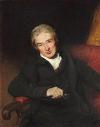William Wilberforce
William Wilberforce was born in Hull on the 24 August 1759. He became the MP for his home city and was a leading campaigner in parliament for the abolition of slavery. During a period of about 20 years, he introduced several anti-slavery bills, which were all rejected.

Wilberforce and others continued to press for the abolition of all slavery. The bill achieving this was not passed until several months after his death on 29 July 1833. He lived long enough to see the second reading.
Between 1824 and 1826, Wilberforce lived locally at The Chestnuts, Honeycroft Hill, Uxbridge. During this period, he retired from parliament due to ill health, sold his London home and bought a house in the more rural setting of Mill Hill.
In June 1824, he had been taken ill on a visit to Lord Gambier at Iver. This illness left him so weakened that he needed to find somewhere quiet to live. As soon as he could be safely moved, he took possession of a small house bordering on Uxbridge Common, where he lived for a time in seclusion but by no means in idleness.
The Chestnuts became his home while he waited for his new house to be ready. The banker, Richard Cox, who lived at Hillingdon House, owned the house, which was on the edge of the park with very few other buildings around. At that time, Honeycroft Hill was known simply as the Ickenham Road and was not a busy thoroughfare.

"staid quietly at Uxbridge, spending the time very pleasantly"
His time at Uxbridge came to an end on 15 June 1826 when he finally moved to Mill Hill. The Chestnuts was rebuilt in the early 1980s. The original house was in such a poor state of repair that it was found necessary to demolish it; although the replacement building is an exact replica of the original.